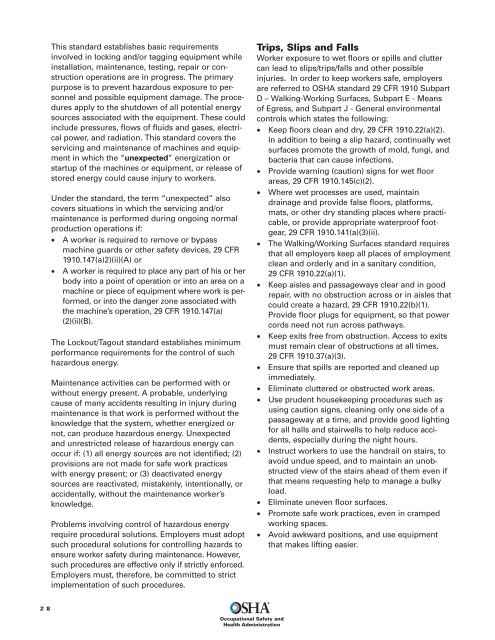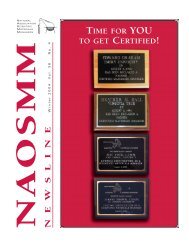Laboratory Safety Guidance
OSHA Lab Safety Guidance - ORS Optical Remote Sensing ...
OSHA Lab Safety Guidance - ORS Optical Remote Sensing ...
- No tags were found...
You also want an ePaper? Increase the reach of your titles
YUMPU automatically turns print PDFs into web optimized ePapers that Google loves.
This standard establishes basic requirements<br />
involved in locking and/or tagging equipment while<br />
installation, maintenance, testing, repair or construction<br />
operations are in progress. The primary<br />
purpose is to prevent hazardous exposure to personnel<br />
and possible equipment damage. The procedures<br />
apply to the shutdown of all potential energy<br />
sources associated with the equipment. These could<br />
include pressures, flows of fluids and gases, electrical<br />
power, and radiation. This standard covers the<br />
servicing and maintenance of machines and equipment<br />
in which the “unexpected” energization or<br />
startup of the machines or equipment, or release of<br />
stored energy could cause injury to workers.<br />
Under the standard, the term “unexpected” also<br />
covers situations in which the servicing and/or<br />
maintenance is performed during ongoing normal<br />
production operations if:<br />
• A worker is required to remove or bypass<br />
machine guards or other safety devices, 29 CFR<br />
1910.147(a)2)(ii)(A) or<br />
• A worker is required to place any part of his or her<br />
body into a point of operation or into an area on a<br />
machine or piece of equipment where work is performed,<br />
or into the danger zone associated with<br />
the machine’s operation, 29 CFR 1910.147(a)<br />
(2)(ii)(B).<br />
The Lockout/Tagout standard establishes minimum<br />
performance requirements for the control of such<br />
hazardous energy.<br />
Maintenance activities can be performed with or<br />
without energy present. A probable, underlying<br />
cause of many accidents resulting in injury during<br />
maintenance is that work is performed without the<br />
knowledge that the system, whether energized or<br />
not, can produce hazardous energy. Unexpected<br />
and unrestricted release of hazardous energy can<br />
occur if: (1) all energy sources are not identified; (2)<br />
provisions are not made for safe work practices<br />
with energy present; or (3) deactivated energy<br />
sources are reactivated, mistakenly, intentionally, or<br />
accidentally, without the maintenance worker’s<br />
knowledge.<br />
Problems involving control of hazardous energy<br />
require procedural solutions. Employers must adopt<br />
such procedural solutions for controlling hazards to<br />
ensure worker safety during maintenance. However,<br />
such procedures are effective only if strictly enforced.<br />
Employers must, therefore, be committed to strict<br />
implementation of such procedures.<br />
Trips, Slips and Falls<br />
Worker exposure to wet floors or spills and clutter<br />
can lead to slips/trips/falls and other possible<br />
injuries. In order to keep workers safe, employers<br />
are referred to OSHA standard 29 CFR 1910 Subpart<br />
D – Walking-Working Surfaces, Subpart E - Means<br />
of Egress, and Subpart J - General environmental<br />
controls which states the following:<br />
• Keep floors clean and dry, 29 CFR 1910.22(a)(2).<br />
In addition to being a slip hazard, continually wet<br />
surfaces promote the growth of mold, fungi, and<br />
bacteria that can cause infections.<br />
• Provide warning (caution) signs for wet floor<br />
areas, 29 CFR 1910.145(c)(2).<br />
• Where wet processes are used, maintain<br />
drainage and provide false floors, platforms,<br />
mats, or other dry standing places where practicable,<br />
or provide appropriate waterproof footgear,<br />
29 CFR 1910.141(a)(3)(ii).<br />
• The Walking/Working Surfaces standard requires<br />
that all employers keep all places of employment<br />
clean and orderly and in a sanitary condition,<br />
29 CFR 1910.22(a)(1).<br />
• Keep aisles and passageways clear and in good<br />
repair, with no obstruction across or in aisles that<br />
could create a hazard, 29 CFR 1910.22(b)(1).<br />
Provide floor plugs for equipment, so that power<br />
cords need not run across pathways.<br />
• Keep exits free from obstruction. Access to exits<br />
must remain clear of obstructions at all times,<br />
29 CFR 1910.37(a)(3).<br />
• Ensure that spills are reported and cleaned up<br />
immediately.<br />
• Eliminate cluttered or obstructed work areas.<br />
• Use prudent housekeeping procedures such as<br />
using caution signs, cleaning only one side of a<br />
passageway at a time, and provide good lighting<br />
for all halls and stairwells to help reduce accidents,<br />
especially during the night hours.<br />
• Instruct workers to use the handrail on stairs, to<br />
avoid undue speed, and to maintain an unobstructed<br />
view of the stairs ahead of them even if<br />
that means requesting help to manage a bulky<br />
load.<br />
• Eliminate uneven floor surfaces.<br />
• Promote safe work practices, even in cramped<br />
working spaces.<br />
• Avoid awkward positions, and use equipment<br />
that makes lifting easier.<br />
2 8<br />
Occupational <strong>Safety</strong> and<br />
Health Administration



